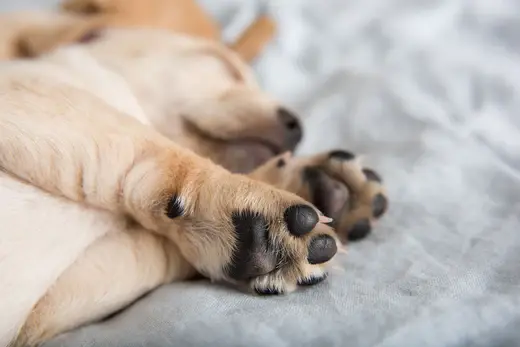Should I Be Cleaning My Dog's Paws?

A regular grooming routine is essential for keeping your dog’s coat in great shape, but what about your dog’s paws? Often, our pups’ feet don’t get the attention they need. In this guide, we’ll cover how often to clean your dog’s paws, signs of injury and infection to watch for, and the best preventative care practices to keep your dog’s paws healthy.
How Often Should You Clean Your Dog’s Paws?
The frequency of paw cleaning depends on your dog’s breed and lifestyle. A mostly indoor dog may not need as much paw care as one that enjoys frequent hikes or outdoor adventures. Dogs with long fur around their paws are more likely to get mats, tangles, and debris stuck between their pads.
While there’s no set rule, it’s a good idea to check and clean your dog’s paws regularly—at least once a week or after outdoor walks. During bath time, always include the paws, and if your dog has long fur, inspect their paws after every walk.
How To Clean Dog Paws
Remove any debris - If your dog has long fur on his paws, he might get things like twigs, spear grass, mud, or burs stuck between his pads. These items can create painful mats, pierce your dog’s skin, or cause general discomfort. When you perform a paw check, feel between each of your pup’s toe pads to remove any debris you encounter and use a damp cloth to wipe away any excess dirt or mud. If your dog has long fur, you may need to trim around items to remove them.
Comb or trim out any mats or tangles - Tangled fur can form mats—and mats can pull your dog’s skin—making his paws painful and hinder his ability to walk comfortably. You may be able to comb out mats in your pup’s fur with the help of a detangling solution. If the mats are too big, carefully cut around them with scissors. If you find that your dog’s paws frequently develop mats, keep the hair between his paw pads trimmed short to prevent tangles.
Check for wounds or punctures - Once you’re sure that your pup’s paws are free of tangles and debris, it’s time to check for wounds, punctures and other signs of irritation. Do your dog’s paws look cracked and dry? Are there any tender spots? Has the pad worn down to expose the skin beneath? Are any of the pads red or swollen? If you spot anything out of the ordinary, monitor your dog’s paws closely to ensure they heal. If the paw pads aren’t healing and your dog is in pain, contact your veterinarian for guidance.
Examine the nails - Keep your eyes out for mud, dirt or debris lodged under his nailbeds, common in dogs with long nails. Your pup’s toenails should be kept short enough so that he can walk without his paws splaying. If you can hear your dog’s nails click when he walks, he’s probably due for a trim. Check the nails for cracks and snags, as these can be painful and become infected. Brittle or cracked nails could indicate a fungal infection or nutritional deficiency. If you notice these symptoms, consult with your veterinarian to address the issue.
Check for unusual odor - If your dog’s paws have an unusual odor, such as corn chips or Fritos, he could have a bacterial or yeast infection. Sometimes these infections occur when a dog’s feet are constantly wet. Fortunately, this issue can usually be corrected with anti-fungal shampoo, Skout's Honor Probiotic Shampoo or topical ointments, so contact your vet if this is the case.
Preventative Paw Care
In addition to cleaning and checking for signs of injury, you can help keep your dog healthy by using products specifically designed to fortify and maintain healthy paws. Skout’s Honor Prebiotic Pet Balm can be used daily to protect paws against dryness and itching. This cream prevents cracks in the pads, which can lead to infection and discomfort. It’s the canine equivalent of using hand lotion!
Cleaning your dog’s paws regularly is an excellent way to spot any problems before they become serious. Having clean, healthy feet will ensure your dog can walk and play comfortably and prevent him from experiencing any potential discomfort, so be sure to work regular paw checks into your grooming routine.



